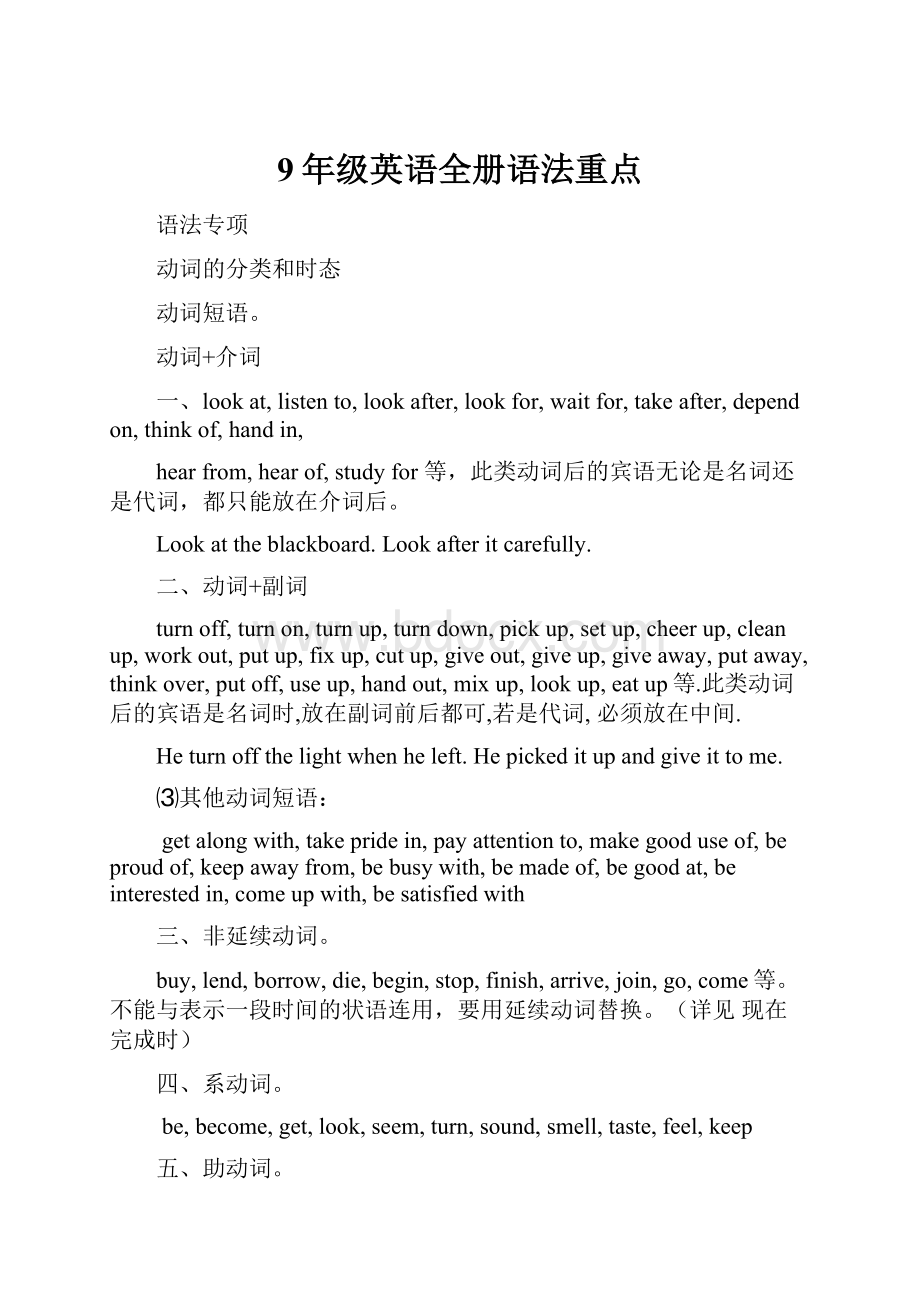 9年级英语全册语法重点.docx
9年级英语全册语法重点.docx
- 文档编号:8791786
- 上传时间:2023-02-01
- 格式:DOCX
- 页数:13
- 大小:23.41KB
9年级英语全册语法重点.docx
《9年级英语全册语法重点.docx》由会员分享,可在线阅读,更多相关《9年级英语全册语法重点.docx(13页珍藏版)》请在冰豆网上搜索。

9年级英语全册语法重点
语法专项
动词的分类和时态
动词短语。
动词+介词
一、lookat,listento,lookafter,lookfor,waitfor,takeafter,dependon,thinkof,handin,
hearfrom,hearof,studyfor等,此类动词后的宾语无论是名词还是代词,都只能放在介词后。
Lookattheblackboard.Lookafteritcarefully.
二、动词+副词
turnoff,turnon,turnup,turndown,pickup,setup,cheerup,cleanup,workout,putup,fixup,cutup,giveout,giveup,giveaway,putaway,thinkover,putoff,useup,handout,mixup,lookup,eatup等.此类动词后的宾语是名词时,放在副词前后都可,若是代词,必须放在中间.
Heturnoffthelightwhenheleft.Hepickeditupandgiveittome.
⑶其他动词短语:
getalongwith,takepridein,payattentionto,makegooduseof,beproudof,keepawayfrom,bebusywith,bemadeof,begoodat,beinterestedin,comeupwith,besatisfiedwith
三、非延续动词。
buy,lend,borrow,die,begin,stop,finish,arrive,join,go,come等。
不能与表示一段时间的状语连用,要用延续动词替换。
(详见现在完成时)
四、系动词。
be,become,get,look,seem,turn,sound,smell,taste,feel,keep
五、助动词。
be,have,has,do,does,did,will,shall(详见P54)
Ⅰ、动词的五种基本形式(详见P55)
Ⅱ、用法:
一般现在时。
肯定句:
主语+V原+其他。
Iusuallygotoschoolbybus.主语(三单)+V三单Sheplaystennisonceaweek.
疑问句:
Do+主语+V原……?
Does+主语(三单)+V原……?
否定句:
主语+don’t+V原.主语(三单)+doesn’t+V原.
用法:
表示经常或习惯性发生的动作。
⑵表示客观真理、事实。
Theearthgoesaroundthesun.
⑶在时间、条件等状语从句中,用一般现在时表示将来。
(if,assoonas,until,when)
Ifitrainstomorrow,wewon’tgotothepark.WhenIgrowup,I’llgotoParis.
时间状语:
Always,often,sometimes,usually,onSunday,onMondayafternoon,everyday/month/year/week,inthemorning,onceayear,twiceaday,threetimesaday等
⑵一般过去时。
⑴表示过去某个时间发生的动作或存在的状态。
Igotuplatethismorning.
⑵表示过去的习惯或经常发生的动作。
WhenIwasinthecountryside.Ioftenswamintheriver.Iusedtogofishing.
2、结构:
肯定句:
主语+V过去+其他。
Wevisitedthemuseumlastweek.
MyfriendTomwenttothebeachyesterday.
疑问句:
Did+主语+V原……?
Didyougoshoppingwithhim?
Didshecookdinnerforherfamily?
否定句:
主语+didn’t+V原……。
Hedidn’tgotoseethemovielastSunday.
3、动词的规则变化。
4、时间状语:
Yesterday,lastnight/week/year/month,lastSunday,in1995,theotherday,justnow,ago等
⑶一般将来时。
用法。
表示将来发生的动作或存在的状态。
其构成:
will+V原
肯定句:
TheywillleaveforShanghainextweek.
否定句:
Wewon’tvisithimtomorrow.
疑问句:
WillyougotoShanghaiintwoweeks?
(注:
当主语为I或we时,问句中可用shall)whereshallwemeettomorrow?
begoingto+V原表示计划、打算做某事。
---whatareyougoingtodonextSunday?
---Iamgoingtolistentomusic.
Lookattheclouds,thereisgoingtorain.
现在进行时be+Ving有时可以表示将来。
常用这种结构的动词:
go,come,leave,stay,start,arriveWe’releavingforLondon.
(4)现在进行时
1、构成:
肯定句:
主语+is/am/are+ving
疑问句:
Is/Am/Are+主语+ving
否定句:
主语+isn’t/amnot/aren’t+ving
用法:
表示正在进行的动作I’mreadingbooknow.
表示现阶段正在进行的动作或状态。
Theyarestudyinghardthisterm.
时间状语
now,thesedays,当句中有look,listen,can’tyousee,canyousee时
Listen!
Heissinging.
(5)现在完成时
1、already/yet已经
already一般用于肯定,与完成时态和进行时连用,也可以用于疑问句,表惊讶。
Ihavealreadyfinishedmywork.
yet一般用于否定或疑问句。
Hasshegonetoschoolyet?
Hisparentshaven’tbeentoParisyet.
现在完成时表示从过去开始延续到现在的动作,常与for,since连用.
现在完成时表示动作才刚结束,但影响还在。
Ihavelostmypen.(结果是我的笔丢失了,我现在没有钢笔了)
--haveyoufoundyourwatchyet?
--No,Ihaven’tfoundityet.
Ihavelivedherefor10years.我已经在这里住了10年(可能还会继续住下去)
3、结构:
肯定句:
主语+have/has+V过分
疑问句:
Have/Has+主语+V过分
否定句:
主语+haven’t/hasn’t+V过分
4、时间状语yet,already,recently,just,once,never,ever,sofar,thesedays.
since+过去的时间点/过去时态for+一段时间inthelast(past)+一段时间
5、延续和非延续动词。
在现在完成时中,有些动词不能与一段时间搭配,所以在与for,since引导的肯定句搭配时,要用其他动词替代:
buy---haveborrow---keepdie---bedeadgo/leave/move---beaway(from)
begin/start---beonfallasleep---beasleepfinish/end---beover
join---bein/bea+名词come---behereopen---beopenclose---beclosed
I’velefttheschoolfor3years.()I’vebeenawayfromtheschoolfor3years.()
6、辨析have/hasbeento,have/hasgoneto,havehasbeenin
have/hasbeento…曾经去过某地,现在已经回来
IhavebeentoParis3times.
have/hasgoneto…去了某地,现在还没回来,可能还在路上。
--whereisyourfather?
---hehasgonetoShanghai.
have/hasbeenin…已经在某地(呆了多久)
MyfamilyhavebeeninChengdufor20years
(6)过去进行时
1、结构was/were+doing
2、用法
①表示过去某段时间正在进行的动作
---whatwereyoudoingat9:
30lastnight?
---IwaswatchingTV.
3、when一般接一般过去时Iwasdoingmyhomeworkwhenmyfathercamehome.
while一般接进行时Whilemymotherwascleaning,Iwentout.Hewasplayingbasketballwhileshewasreadingbooks.
(7)过去完成时
1、过去完成时表示过去某个时间以前好或过去某个动作以前,已经发生的动作或状态。
(过去的过去)
WhenIgottoschool,IrealizedIhadleftmybackpackathone.Bythetimeshegottoclass,theteacherhadstartedteaching.
2、结构:
had+V过分
3、时间状语:
bythetime+表示过去的时间状语从句,主句用过去完成时。
Bythetimewearrivedattheshop,thebushadleft.
动词、短语辨析
1、dress,puton,wear
dresssb/oneself(in)给某人穿衣。
Shedressedherbabyinaredskirt.
dressup打扮、装扮Thegirldressedherselfupantwenttotheparty.
Puton(动作)穿上It’scoldoutside,putonyourcoat.
wear=bein穿着、戴着LilywearsT-shirteveryday.=LilyisinT-shirteveryday.
2、arrive,get,reach
arrive+at/in+地点WhendidyouarriveinChengdu?
getto+地点Howdoyougettoschool?
reach+地点Whenshereachedthesupermarket,hermotherisshopping.
3、die,dead,death,dying
die(动词)死亡→(过去时)diedHisfrienddied3yearsago.
dead(die的过去分词,用于完成时,与for,since搭配)
Hisfriendhasbeendeadfor3years.
death(名词)死亡Hisdeathistheloss(损失)ofChina.
dying垂死的Thepoormanisdying.
lose,forget,leave
lose丢失、失去
forget忘记forgettodosth/forgetdoingsth
leave+地点“把某物落在某地)
以must开头的疑问句,肯定回答用must,否定回答用needn’t
---MustIfinishtheworktoday?
---No,youneedn’t.
---MayIcomein?
---No,youmusn’t.
非谓语动词
动词不定式
结构to+V原/notto+V原
用法
①作主语+V三单TospeakEnglishisnoteasyforus.
②作表语Myjobistocleantheroom.
③作宾语Helikestoplaysoccer.
④作宾语补足语Sheaskedmenottospeakloudly.
⑤作定语Haveyougotanythingtoeat?
⑥作状语IwenttothelibrarytostudyEnglish.(表目的)
注:
作宾语的不定式如果是不及物动词,且与所修饰的词之间有动宾关系,要在不定式后加介词。
Idon’thaveenoughtimetostudyforthetest,soIhavesomethingtoworryabout.
Ineedaroomtolivein
不定式作宾语:
want,refuse,wish,need,choose,hope,agree,wouldlike,offer,expect,decide,ask+todosth
Ihopetofindagoodjobaftergraduatingfromschool.
不定式作宾补:
tell,ask,want,allow,get,wouldlike,encourage+sb(not)todosth
Mymotherasksmenottoplaycomputergamesbeforefinishinghomework.
不带to的不定式:
whynot+do…?
Hadbetter(not)dosth.
Wouldbetter(not)do…Could/Would/Willyou(not)do…..?
另外,有些感官动词和使役动词也不带to:
Hear,see,watch,notice,feel,let,make,have+sb(not)do….但变为被动时,要加to
Thebossmadethemworkthewholeday.
Theyweremadetoworkthewholeday.(被动)
感叹句
(一)what引导
1、what+a/an+adj+可数名词单数+主语+谓语Whatabeautifulgirlsheis!
2、what+adj+可数名词复数、不可数名词+主语+谓语Whatsweetwateritis!
(二)how引导
How+adj/adv+主语+谓语Howinterestingthefilmis!
(三)如何判断用what还是how
凡是有a/an开头,多用what;凡是adj直接加名词的,多用what;其他一般用how.
状语从句
时间状语从句
when,while,as,before,after,since,until,assoonas.
当主语是一般将来时或祈使句或有情态动词时,从句用一般现在时,“主将从现”
I’llringyouassoonasIgettoschool.我一到学校就打电话给你。
肯定句:
until=till直到I’llwaitforyouuntilyoucomeback.
否定句:
until=beforenot….until直到….才……Ididn’tgotobeduntilIfinishedmyhomework.。
二、条件状语从句
if,aslongas(只要),unless(除非)
主将从现I’llvisityouifitdoesn’traintomorrow.Useyourhead,andyou’llfindaway.
Unlessyouworkhard,you’llgetagoodjob.Ifthetrafficlightsaregreen,youcancrossthestreet.
宾语从句
一、宾语从句的语态。
宾语从句要用陈述语态
---Doyouknow______forShanghailastnight?
A.whattimeheleavesB.whattimedidheleaveC.whattimeheleft.
二、主句与从句时态一致。
1、如果主句用现在的某个时态,宾语从句视实际情况而定。
Iwonderifyoucanhelpme.我想知道你是否能帮我。
2、主过---从过
HetoldmethathewouldtakepartinEnglishclub.他告诉我他将参加英语俱乐部。
HeaskedmeifIusedhisbike.他问我是否我用过他的自行车。
如果是客观事实,宾语从句用一般现在时。
Jimtoldmethattheearthisround.Jim告诉我地球是圆的。
三、连接词
1、that可省略,that作主语时不能省。
2、what,which,who,whose,whomHeaskedmewhosethebookis.
3、when,how,where,whyCouldyoutellmewheretherestaurantis.
Doyouknowhowtogettothebank?
if/whether是否
以下情况只能用whether:
与ornot连用Canyoutellmewhetherwegoornot.
作介词后的宾语从句I’mworriedaboutwhetherweshouldstudyeachother,
跟不定式todoHaveyoudecidedwhethertogowithus.
定语从句的用法
定语从句中只能使用that的情况
1.当先行词为anything,everything,nothing等不定代词时,只能使用“that”。
例:
IsthereanythingthatIcandoforyou?
(我能给你做点什么吗?
)
2.当先行词为all,any,much,many词时,只能使用“that”。
例:
Tomtoldhermotherallthathadhappened.(汤姆把事情的全部情况告诉了他的妈妈。
)
3.当先行词是形容词最高级或被形容词最高级修饰时,只能使用“that”。
例:
ThisisthemostwonderfultimethatIhaveeverhad.(这是我度过的最美好的时光。
)
4.当先行词是序数词修饰时,只能使用“that”。
例:
Hewasthefirstpersonthatpassedtheexam.他是第一个通过考试的人。
5.先行词被theonly,thevery,thesame,thelast修饰时,只能使用“that”。
例:
Thiswillbethelastchancethathecanget.(这将会是他得到的唯一机会。
) Heistheonlypersonthatcanhelpyouout.(他是唯一能帮你的人。
)
6.先行词里同时含有人或物时,只能使用“that”。
例:
Theytalkedofthingsandpersonsthattheyrememberedintheschool.(他们谈论他们记得的有关学校的事和人。
)
7.当主句是以who,which开头的特殊疑问句或先行词是who时,只能使用“that”。
例:
Whichisthebookthatheboughtfromthelibraryyesterday?
(哪本是你们昨天从图书馆借的书?
)
注意:
●指物时,在介词后只能用which,而不能用that.
●定词从句修饰代表地点、时间的先行词时,要看代表先行词的关系词在定语从句中是否作谓语动词的宾语.如作动词的宾语,就要用关系代词that或which引导定语从句.反之,要用关系副词where(表地点)或when(表时间),在定语从句中作状语.
如:
Marywouldneverforgettheeveningwhenshelostthebook.I’vebeentothecitythatyouvisitedlastweek.
被动语态注意事项
●构成
被动语态表明一个被动性动作,它由“助动词be+及物动词的过去分词”构成。
一般现在时am/is/are+pp.
一般过去时was/were+pp.
一般将来时willbe+pp.am/is/aregoingtobe+pp.
情态动词may/can/must/shouldbe+pp.
被动语态否定式为benot+pp.,
情态动词被动语态否定式为情态动词+notbe+pp..
●主动语态变为被动语态时,通常将主动语态中的宾语变为被动语态的主语;主动语
- 配套讲稿:
如PPT文件的首页显示word图标,表示该PPT已包含配套word讲稿。双击word图标可打开word文档。
- 特殊限制:
部分文档作品中含有的国旗、国徽等图片,仅作为作品整体效果示例展示,禁止商用。设计者仅对作品中独创性部分享有著作权。
- 关 键 词:
- 年级 英语 语法 重点
 冰豆网所有资源均是用户自行上传分享,仅供网友学习交流,未经上传用户书面授权,请勿作他用。
冰豆网所有资源均是用户自行上传分享,仅供网友学习交流,未经上传用户书面授权,请勿作他用。


 1212中级汽车维修工考试试题三.docx
1212中级汽车维修工考试试题三.docx
